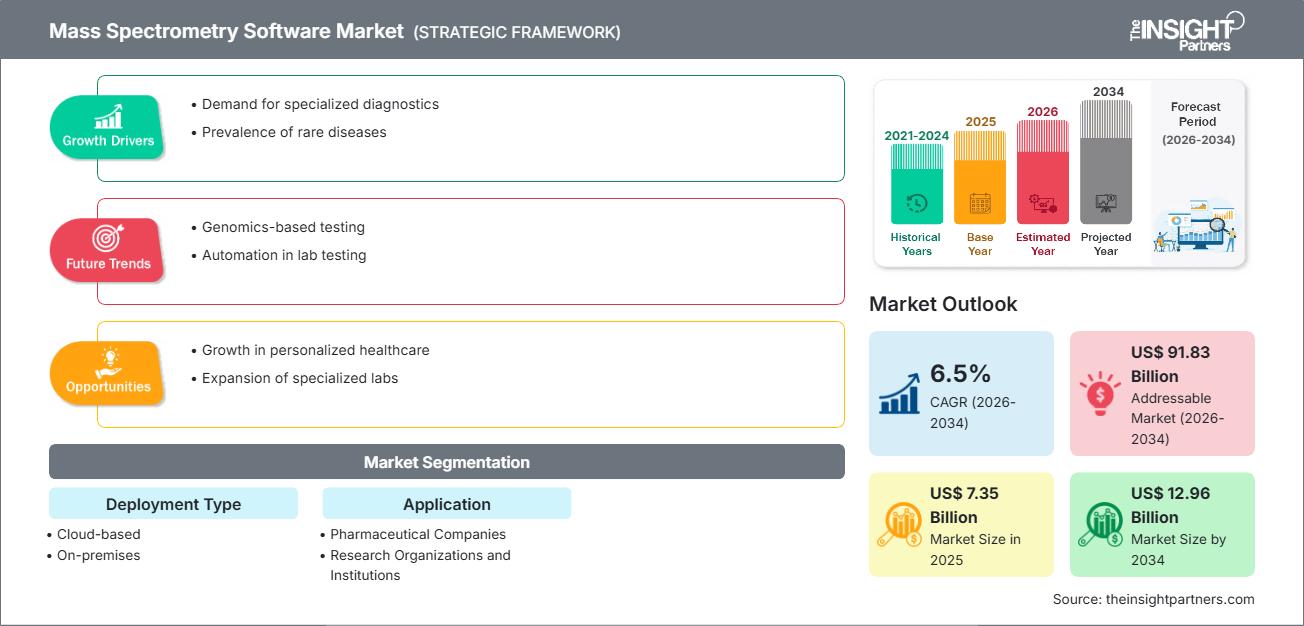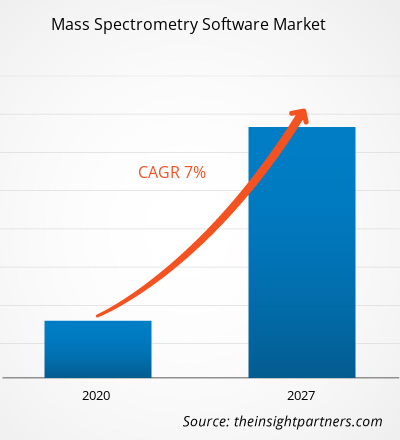질량 분석 소프트웨어 시장 규모는 2025년 73억 5천만 달러에서 2034년 129억 6천만 달러로 성장할 것으로 예상되며, 2026년부터 2034년까지 연평균 성장률(CAGR)은 6.5%를 기록할 것으로 전망됩니다.
질량 분석 소프트웨어 시장 분석
질량 분석 소프트웨어 시장은 유전체학 및 단백체학 분야의 응용 증가와 연구 및 제약 분야의 수요 증가에 힘입어 지속적인 성장을 보일 것으로 전망됩니다. 시장 성장은 고처리량 및 고정밀 데이터 처리 요구와 확장성 및 원격 접속 문제를 해결하기 위한 클라우드 기반 솔루션 사용 증가에 의해 주도되고 있습니다. 또한, AI/ML 기반 데이터 해석 및 자동화 기술의 발전은 시장 성장을 더욱 촉진하고 있습니다. 질량 분석 장비의 도입과 생명 과학 분야 연구 개발 투자 증가는 시장 동향에 상당한 영향을 미치고 있습니다.
질량 분석 소프트웨어 시장 개요
질량 분석 소프트웨어는 질량 분석 워크플로우를 지원하도록 설계된 소프트웨어 종류입니다. 이러한 도구는 데이터 수집, 데이터 처리, 시각화 및 질량 분석기 제어와 같은 핵심 작업을 수행합니다. 이러한 기능을 제공함으로써 과학자, 연구원 및 분석가는 복잡한 스펙트럼을 해석하고, 바이오마커를 식별하고, 분석 대상 물질을 정량화하고, 질량 분석 원시 데이터에서 실행 가능한 통찰력을 도출할 수 있습니다. 결과적으로 연구 효율성이 향상되고, 단백질체학 및 대사체학 연구의 정확도가 높아지며, 제약, 임상 및 학술 분야에서 질량 분석의 활용도가 향상됩니다.
이 보고서를 귀하의 요구사항에 맞게 맞춤 설정하십시오.
모든 보고서에 대한 맞춤형 서비스(본 보고서의 일부 또는 국가별 분석, Excel 데이터 팩 포함)를 무료로 제공해 드립니다. 또한 스타트업 및 대학을 위한 다양한 할인 혜택도 누리실 수 있습니다.
질량 분석 소프트웨어 시장: 전략적 고찰

-
이 보고서에서 주요 시장 동향을 확인하세요.이 무료 샘플에는 시장 동향부터 추정치 및 예측에 이르기까지 다양한 데이터 분석이 포함됩니다.
질량 분석 소프트웨어 시장 동인 및 기회
시장 동인:
- 유전체학 및 단백체학 분야에서의 활용 증가: 유전체학 및 단백체학 연구의 급증으로 정확한 바이오마커 식별을 위한 질량 분석 소프트웨어에 대한 의존도가 높아지고 있습니다.
- 제약 분야 연구 개발 증가: 제약 회사들이 신약 개발에 대한 투자를 늘리고 있으며, 이에 따라 첨단 데이터 처리 및 분석 역량이 요구되고 있습니다.
- 클라우드 도입: 대량 생산 소프트웨어의 클라우드 기반 배포로의 전환은 확장성, 접근성 및 배포 시간 단축을 제공하여 도입을 촉진합니다.
- 기술 혁신: 인공지능, 머신러닝 알고리즘 및 자동화는 데이터 분석의 정확도를 높이고 수작업 부담을 줄여줍니다.
시장 기회:
- 신흥 연구 시장의 확장: 신흥 경제국의 연구 자금 지원 및 생명 과학 인프라 증가는 상당한 잠재력을 제시합니다.
- 다중 오믹스 플랫폼과의 통합: 질량 분석 데이터와 유전체학, 전사체학, 대사체학 데이터를 원활하게 통합하는 소프트웨어는 새로운 활용 사례를 열어줍니다.
- 하이브리드 및 SaaS 모델: 온프레미스/클라우드 혼합 배포 방식과 구독 기반 소프트웨어를 제공하면 특히 소규모 연구실 및 기관을 포함한 더 많은 사용자를 유치할 수 있습니다.
- AI 기반 분석: 스펙트럼 분해, 피크 검출 및 정량화를 위한 AI 기반 모듈 개발은 핵심적인 차별화 요소가 될 수 있습니다.
질량 분석 소프트웨어 시장 보고서 세분화 분석
배포 유형별:
- 클라우드 기반
- 구내
신청을 통해:
- 제약 회사
- 연구기관 및 학술기관
지리학별:
- 북아메리카
- 유럽
- 아시아 태평양
- 중동 및 아프리카
- 남미 및 중앙아메리카
질량 분석 소프트웨어 시장 지역별 분석
인사이트 파트너스의 분석가들은 예측 기간 동안 질량 분석 소프트웨어 시장에 영향을 미치는 지역별 동향과 요인을 자세히 설명했습니다. 이 섹션에서는 북미, 유럽, 아시아 태평양, 중동 및 아프리카, 남미 및 중앙아메리카를 아우르는 질량 분석 소프트웨어 시장 세그먼트와 지역별 현황도 다룹니다.
질량 분석 소프트웨어 시장 보고서 범위
| 보고서 속성 | 세부 |
|---|---|
| 2025년 시장 규모 | 73억 5천만 달러 |
| 2034년 시장 규모 | 129억 6천만 달러 |
| 글로벌 연평균 성장률(2026년~2034년) | 6.5% |
| 역사적 데이터 | 2021-2024 |
| 예측 기간 | 2026-2034 |
| 포함되는 부문 |
배포 유형별
|
| 대상 지역 및 국가 |
북아메리카
|
| 시장 선도 기업 및 주요 기업 프로필 |
|
질량 분석 소프트웨어 시장 참여자 밀도: 비즈니스 역학에 미치는 영향 이해
질량 분석 소프트웨어 시장은 소비자 선호도 변화, 기술 발전, 제품 이점 인식 제고 등 여러 요인으로 인한 최종 사용자 수요 증가에 힘입어 빠르게 성장하고 있습니다. 수요 증가에 따라 기업들은 제품군을 확장하고, 소비자 요구를 충족하기 위한 혁신을 추진하며, 새로운 트렌드를 활용하여 시장 성장을 더욱 촉진하고 있습니다.

- 질량 분석 소프트웨어 시장의 주요 업체 개요를 확인하세요.
질량 분석 소프트웨어 시장 점유율 분석 (지역별)
- 북미: 강력한 생명과학 연구 인프라, 대규모 제약 산업, 그리고 클라우드 및 AI 기술의 조기 도입 덕분에 역사적으로 지배적인 위치를 차지해 왔습니다.
- 유럽: 이 지역은 학술 연구, 엄격한 규제, 그리고 성숙한 바이오 기술 산업에 힘입어 상당한 수요를 보이고 있습니다.
- 아시아 태평양 지역: 연구 개발 지출 증가, 바이오테크 기업 수 증가, 연구 인프라 구축을 위한 정부 지원에 힘입어 가장 빠르게 성장하는 시장입니다.
- 중동 및 아프리카, 남미 및 중앙아메리카: 이 지역은 연구 기관 및 생명 과학 역량에 대한 투자가 증가하고 있는 신흥 시장입니다. 클라우드 솔루션과 SaaS 모델은 향후 성장 기회를 제공할 것입니다.
질량 분석 소프트웨어 시장 참여자 밀도: 비즈니스 역학에 미치는 영향 이해
질량 분석 소프트웨어 시장은 소수의 주요 업체가 시장을 장악하고 있지만, 틈새시장 전문 업체들도 존재하는 비교적 집중된 시장입니다.
경쟁력 차별화 전략:
- 인공지능/머신러닝 기반 모듈을 개발하여 분광 데이터 해석을 개선합니다.
- 다양한 규모의 연구실에 맞춰 확장 가능한 클라우드 기반 소프트웨어를 제공합니다.
- 전략적 제휴 또는 인수합병을 통해 멀티오믹스 데이터 플랫폼 전반의 역량을 통합합니다.
- 단백질체학, 대사체학 및 바이오마커 발굴을 위한 특수 데이터 처리 도구를 제공합니다.
기회 및 전략적 움직임:
- 제약 연구개발 연구소와 협력하여 맞춤형 소프트웨어 솔루션을 공동 개발합니다.
- 예측 분석 및 실시간 스펙트럼 피드백을 제공하기 위한 연구 개발에 투자합니다.
- 현지화된 배포, 교육 및 클라우드 플랫폼을 통해 시장 침투율이 낮은 시장으로 확장합니다.
- 점진적 도입이 가능한 모듈형 플랫폼을 제공합니다(예: 데이터 분석부터 시작하여 나중에 제어 및 시각화 기능을 추가).
질량 분석 소프트웨어 시장 주요 기업:
- 써모 피셔 사이언티픽 주식회사
- 애질런트 테크놀로지스 주식회사
- 워터스 코퍼레이션
- 브루커 코퍼레이션
- 사이엑스(다나허 코퍼레이션)
- 시마즈 과학 기기
- 첨단 화학 개발
- 어댑타스 솔루션
- 스펙트럴웍스 주식회사
본 시장 조사에서 분석 대상에 포함될 수 있는 다른 기업은 다음과 같습니다.
- ACD/랩스
- 애드비온 주식회사
- 제네데이터 AG
- 전올 주식회사
- LECO 주식회사
- 오픈MS
- 프로테옴 소프트웨어 주식회사
- 매스테크 주식회사
- 비선형 동역학
- 체르노 바이오사이언스
질량 분석 소프트웨어 시장 뉴스 및 최근 동향
- 클라우드 기반 구축에 대한 관심이 점점 높아지고 있으며, 많은 공급업체들이 접근성, 에너지 비용 절감, 확장 가능한 인프라를 주요 장점으로 강조하고 있습니다.
- 기술적인 측면에서, 피크 검출, 디컨볼루션 및 해석을 위한 AI 기반 데이터 분석은 소프트웨어 제공업체들 사이에서 점점 더 보편화되고 있으며, 이는 처리량을 개선하고 수동 개입을 줄이는 것을 목표로 합니다.
- 전략적 움직임: 공급업체들은 특히 단백질체학 및 대사체학 응용 분야를 위해 특정 분야에 특화된 도구를 공동 개발하기 위해 학계 및 제약 연구소와 파트너십을 맺는 사례가 늘고 있습니다.
질량 분석 소프트웨어 시장 보고서 범위 및 제공 내용
Insight Partners의 "질량 분석 소프트웨어 시장 전망(2021-2034)" 보고서는 다음과 같은 내용을 포괄적이고 상세하게 분석합니다.
- 주요 부문별 글로벌 및 지역 시장 규모 및 전망.
- 시장 동향에 대한 심층 분석과 함께 시장 성장 동력, 제약 요인 및 기회에 대해 자세히 살펴보겠습니다.
- 상세한 PEST(정치, 경제, 사회, 기술) 및 SWOT(강점, 약점, 기회, 위협) 분석
- 경쟁 환경: 시장 집중도, 주요 업체 분석 및 최근 전략적 행보.
- 인수합병, 파트너십 및 제품 출시 관련 개발 사항.
- 선도 기업 및 신흥 기업의 기업 프로필을 통해 제품 포트폴리오, 사업 전략 및 시장 포지셔닝에 대한 심층 분석을 제공합니다.
- 과거 분석(2년), 기준 연도, CAGR을 포함한 예측(7년)
- PEST 및 SWOT 분석
- 시장 규모 가치/거래량 - 글로벌, 지역, 국가
- 산업 및 경쟁 환경
- Excel 데이터세트
사용 후기
구매 이유
- 정보에 기반한 의사 결정
- 시장 역학 이해
- 경쟁 분석
- 고객 인사이트
- 시장 예측
- 위험 완화
- 전략 기획
- 투자 타당성 분석
- 신흥 시장 파악
- 마케팅 전략 강화
- 운영 효율성 향상
- 규제 동향에 발맞춰 대응






















 무료 샘플 받기 - 질량 분석 소프트웨어 시장
무료 샘플 받기 - 질량 분석 소프트웨어 시장